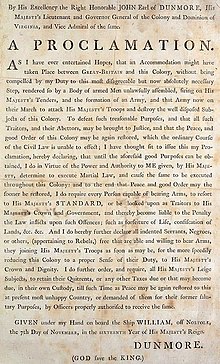| Dunmore's Proclamation | |
|---|---|
 | |
| Created | November 7, 1775 |
| Ratified | November 14, 1775 |
| Author(s) | John Murray, 4th Earl of Dunmore |
| Purpose | To declare martial law, and to encourage indentured servants and slaves of rebels in Virginia to leave their masters and support the Loyalist cause |
Dunmore's Proclamation is a historical document signed on November 7, 1775, by John Murray, 4th Earl of Dunmore, royal governor of the British colony of Virginia. The proclamation declared martial law[1] and promised freedom for slaves of American Patriots who left their owners and joined the British Army, becoming Black Loyalists. The same right was offered to indentured servants. Most relevant historians agree that the proclamation was chiefly designed for practical rather than moral reasons.[2][3]
Formally proclaimed on November 15, its publication prompted between 800 and 2000 slaves (from both Patriot and Loyalist owners) to run away and enlist with Dunmore. It also raised a furor among Virginia's slave-owning elites (again of both political persuasions), to whom the possibility of a slave rebellion was a major fear. The proclamation ultimately failed in meeting Dunmore's objectives; he was forced out of the colony in 1776, taking about 300 former slaves with him. The 1779 Philipsburg Proclamation applied to all the colonies. During the course of the war, between 80,000 and 100,000 slaves escaped from the plantations.[4]
- ^ Scribner, Robert L. (1983). Revolutionary Virginia, the Road to Independence. University of Virginia Press. pp. xxiv. ISBN 0-8139-0748-9.
- ^ Frey, Sylvia R. (1991). Water From the Rock: Black Resistance in a Revolutionary Age. Princeton, New Jersey: Princeton University Press. p. 63.
- ^ To Make Our World Anew, Volume I: A History of African Americans to 1880, p. 120
- ^ Rough Crossings: Britain, the Slaves, and the American Revolution: Simon Schama, p. 19
© MMXXIII Rich X Search. We shall prevail. All rights reserved. Rich X Search
